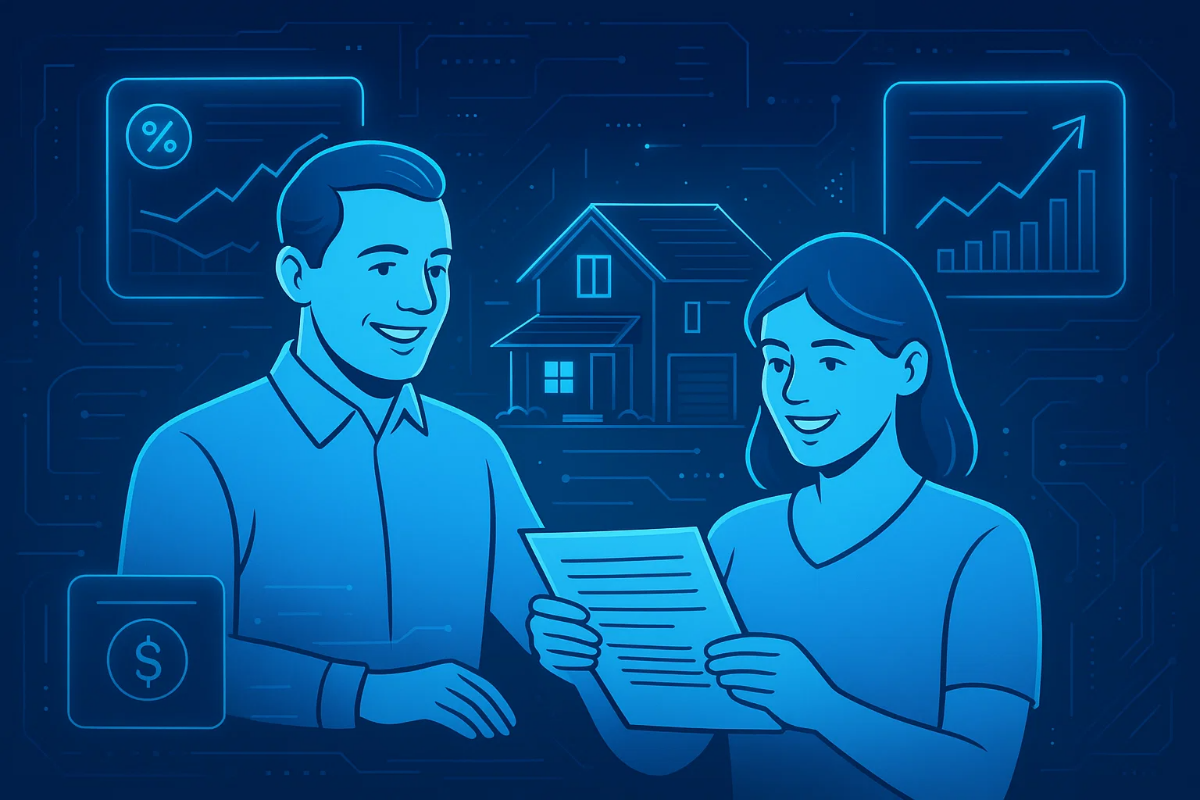Introduction
Refinancing a home loan can be one of the most effective ways to improve your financial situation, but many homeowners struggle to understand when it’s worthwhile. This guide to mortgage refinance walks you through how the process works, what to expect, and how to make informed decisions. You’ll learn key benefits, risks, best practices, and strategies used by financial experts and major institutions.

Understanding Mortgage Refinance
Mortgage refinance means replacing your current home loan with a new one. Homeowners typically refinance to secure a lower interest rate, change their loan term, tap into home equity, or switch from an adjustable-rate mortgage (ARM) to a fixed-rate mortgage.
How Refinance Works
When you refinance, your lender pays off your existing mortgage and issues a new one with updated terms. You then begin making payments on the new loan.
Refinancing may be beneficial when:
-
Interest rates drop
-
Your credit score improves
-
You want to reduce monthly payments
-
You want to shorten your loan term
-
You want to convert home equity into cash (cash-out refinance)
-
You want more predictable payments with a fixed-rate loan
The Key Players in Refinance
Refinance processes often involve:
-
Mortgage lenders (e.g., Wells Fargo, Chase, Rocket Mortgage)
-
Appraisers
-
Credit bureaus
-
Title and escrow companies
These entities help assess risk, verify property value, and ensure legal compliance.
When Does Refinancing Make Sense?
Refinancing is not always the right move. Before you proceed, evaluate whether it aligns with your financial goals.
Lowering Your Interest Rate
This is the most common reason homeowners refinance. A lower interest rate reduces your monthly payment and total loan cost.
Example:
If you drop your rate from 6.5% to 5%, you could save tens of thousands of dollars over 30 years.
Shortening Your Loan Term
Choosing a 15-year mortgage instead of a 30-year one means higher monthly payments but substantial savings in interest.
Industry fact:
According to Freddie Mac, homeowners who refinance into a shorter term often save more than 40% in interest compared to a standard 30-year loan.
Switching From ARM to Fixed Rates
Adjustable-rate mortgages can become expensive when rates rise. Refinancing into a fixed-rate mortgage provides long-term stability.
Accessing Home Equity
A cash-out refinance lets you borrow from your home’s equity.
Common uses include:
-
Home improvements
-
Debt consolidation
-
College tuition
-
Investment opportunities
However, you increase your loan balance, so consider this carefully.
Costs You Need to Consider Before Refinancing
Refinancing is not free. Understanding costs helps you decide whether the savings justify the process.
Closing Costs
Closing costs typically range from 2% to 6% of the loan amount.
They may include:
-
Application fees
-
Appraisal fees
-
Origination fees
-
Credit check fees
-
Title search and insurance
Break-Even Point
To calculate whether refinancing is worth it, estimate your break-even point:
Break-even = Total closing costs / Monthly savings
If you plan to move before reaching the break-even point, refinancing may not pay off.
Prepayment Penalties
Some mortgages include penalties if you pay off your loan early. Check your original mortgage agreement to avoid surprises.
How to Prepare for a Mortgage Refinance
Improve Your Credit Score
Lenders reward strong credit with better rates. Aim for a score of at least:
-
620 for conventional loans
-
740+ for the best rates
Tips:
-
Pay down credit cards
-
Avoid new loans
-
Check your report for errors
Gather Financial Documents
Lenders will request documentation similar to your original mortgage application:
-
Tax returns
-
Pay stubs
-
Bank statements
-
Employment verification
Check Your Home Equity
Most lenders require at least 20% equity for favorable terms. A home appraisal will confirm your property value.
Compare Lenders
Interest rates differ across lenders. Tools such as Bankrate, NerdWallet, and LendingTree help you compare real-time offers.
Types of Mortgage Refinancing
Rate-and-Term Refinance
The most common type: you change your interest rate, loan term, or both. It does not involve withdrawing equity.
Cash-Out Refinance
You replace your mortgage with a higher loan amount and receive the difference as cash.
Best for:
-
Renovations
-
Debt consolidation
-
Investing
Could be risky if home values fall.
Cash-In Refinance
Here, you pay additional money upfront to reduce your loan balance. This can lower your rate and eliminate PMI (private mortgage insurance).
Streamline Refinance
Certain government-backed loans offer simplified refinancing:
-
FHA Streamline
-
VA IRRRL (Interest Rate Reduction Refinance Loan)
-
USDA Streamlined Assist
These options usually require less paperwork and no appraisal.
Common Mistakes Homeowners Should Avoid
Focusing Only on the Monthly Payment
A lower payment may look attractive, but if it stretches your loan term, you may pay more interest overall.
Ignoring Closing Costs
Saving $100 per month is not helpful if you spend $8,000 on closing costs and move in two years.
Failing to Lock the Rate
Interest rates fluctuate daily. Always lock your rate once you’re satisfied with the offer.
Refinancing Too Often
Each refinance resets your amortization schedule. Frequent refinancing can delay your progress toward principal reduction.
Not Comparing Lenders
Many homeowners accept the first offer. Comparing just three lenders can save you over $5,000, according to Consumer Financial Protection Bureau (CFPB) data.
How to Choose the Best Time to Refinance
Market Timing
Refinancing makes sense when:
-
Interest rates drop 0.5–1%
-
Your credit score improves
-
Home equity rises
-
Your financial situation stabilizes
Personal Timing
Good personal reasons include:
-
Higher income
-
Elimination of high-interest debt
-
Plans to stay in your home for 5+ years
Step-by-Step Guide to Refinancing Your Mortgage
Step 1: Evaluate Your Goals
Do you want lower payments, faster payoff, or cash for improvements?
Step 2: Check Your Credit and Finances
Ensure your profile qualifies you for competitive rates.
Step 3: Compare Loan Estimates
Request quotes from at least three lenders.
Step 4: Submit an Application
Provide documentation and authorize a credit check.
Step 5: Get a Home Appraisal
Your lender will schedule this to confirm your property’s value.
Step 6: Review and Lock Your Rate
Locking protects you from market changes.
Step 7: Close on Your New Loan
Sign final documents and begin repayment.
How Economic Factors Influence Refinance Rates
Mortgage rates are influenced by:
-
Federal Reserve policy
-
Inflation
-
Bond market trends
-
Employment data
For example, when inflation rises, mortgage rates usually increase. Harvard Business School research has shown a strong correlation between inflation expectations and long-term mortgage rates.
Understanding these factors helps you decide when to refinance strategically.
Author’s Insight
From my experience working with homeowners and financial advisors, the most successful refinance outcomes come from clear planning. Many borrowers rush into refinancing because they hear rates are dropping, only to discover the costs outweigh the benefits. One homeowner I recently helped refinanced after improving her credit score from 670 to 740. She secured a rate 1.25% lower and saved more than $38,000 in total interest. The key was preparation—not urgency.
My advice: slow down, compare options, and always calculate your break-even point.
Conclusion
Mortgage refinance can be a powerful financial tool when used wisely. By understanding how refinancing works, evaluating costs, choosing the right timing, and avoiding common mistakes, you can significantly improve your financial health. Whether your goal is to lower payments, shorten your loan term, or access home equity, this guide to mortgage refinance equips you with the knowledge needed to make confident decisions.






